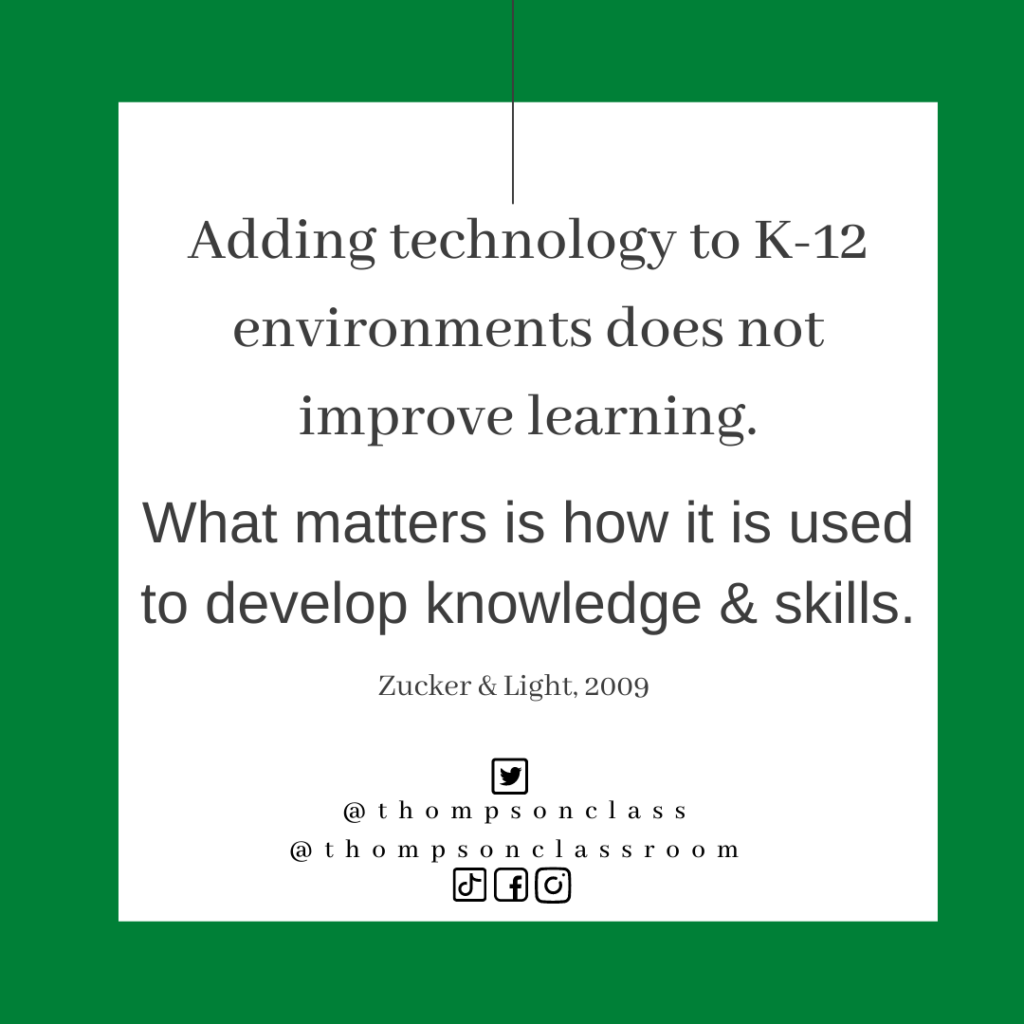No Statistical Difference

On Mondays I share a different ed tech quote on our Thompson Classroom social media pages for our staff to consider.

*This article is a repost from 2017
When it comes to educational technology (ed tech) I find that it can be one of those ed topics that can become incredibly polarizing. You either find educators who are enthusiastically supportive of the implementation of various forms of ed tech or you find educators who will use ed tech if they have to but tend to stick with other materials and strategies that they are more comfortable with. Admittedly I fall into the first category and can sometimes be guilty of finding myself in an “echo chamber” that supports my beliefs because many of my colleagues who I chat with regularly share this interest with me.
Our discussion this week, however, was not simply centred on our views towards ed tech but rather does educational technology make a significant difference when it comes to student achievement in the classroom.
When it comes to educational research it was brought up that one must always question the context of the research that was performed. Education is never a black-or-white scenario. Education is full of grey-areas that are subject to such a high number of ever-changing variables that make it difficult (if not impossible) to transfer the results of educational research to different classrooms. Even within my personal teaching context I can say with 100% confidence that a particular teaching strategy will produce different results depending on the time of day, the attitude of my students, my personal attitude, the subject we’re studying, the topic we’re discussing, etc.
This viewpoint was echoed by Oblinger and Hawkins (2006) who co-authored an article titled, The myth about no significant difference, in which they open by challenging those who claim to have results for either side of this argument as a student’s learning never occurs in a “no-tech only” or “high-tech only” situation. Our students are surrounded by various forms of technology throughout their day and the authors argue that the question shouldn’t be about whether technology has increased student achievement but rather one of the following:
1. Do we think of technology as a solution in itself or as a means to an end?
– adding technology without altering our pedagogy is not a solution
2. Do we assume that using technology is an either/or proposition?
– technologies can blend, one does not have to completely replace another
3. Have we identified those processes and activities we want improved and looked at how technology can facilitate those actions?
– technology makes learning opportunities more readily accessible and flexible
4. Are we doing the same things with technology or are we taking advantage of the unique capabilities of technology and redesigning our activities?
– don’t replicate pencil and paper tasks; add other elements to enhance the learning opportunity
This video clip of Nicky Hockly appears to share a similar viewpoint to Oblinger & Hawkins.“Does technology help students learn better? It depends….”
Uploaded to YouTube by Oxford University Press ETL. Available online at: https://www.youtube.com/watch?v=Q6mr4bzzXtU
The authors went on to argue that learning does not occur simply as a result of technology it depends on a number of factors including:
1. Motivation
– this all depends on what students are motivated by (which can change rapidly)
– technology can make motivation opportunities more accessible to students
2. Opportunities
– technology can help provide opportunities for all students
3. Learning as an Active Process
– the more active = the more learning occurs
– visuals, simulations, collaborative opportunities, etc can assist in increasing activity
4. Interaction with Others
– any space can become a learning space due to wireless options
– rural and remote barriers can be lifted
5. Transfer Learning to Real-World Situations
– various versions of what someone’s “real world” looks like
– augmented reality, video conference with experts, blogging, etc can bring in the real world
When reflecting on my personal beliefs towards the question, does educational technology make a significant difference when it comes to student achievement in the classroom, I find myself siding with the authors. I do not believe that technology alone can have any significant difference on student achievement. As with anything that is implemented in the classroom it relies on a number of factors that can change as our learning situation changes. As educators it is our duty to implement technology with purpose that is backed by strong pedagogy and rooted in curricular theory. While technology alone cannot increase student achievement in the classroom being aware of the factors affecting student learning, accounting for your classroom’s unique variables, identifying a purpose, and backing all plans with strong pedagogy and theory will allow for the highest chance of success.
Weekly Reading References:
Post (old interview) with Larry Cuban on change in education – still relevant commentary. https://larrycuban.wordpress.com/2017/08/18/fads-and-fireflies-the-difficulties-of-sustaining-change/
Nantais, M. (2014). Social media pedagogy: A multiple case study. (unpublished doctoral dissertation) University of Manitoba, Winnipeg, MB. pp 40-50.
Oblinger, D.G., & Hawkins, D.L. (2006). The myth about no significant difference. Educause Review, 41(6), pp 14-15.
1 thought on “No Statistical Difference”